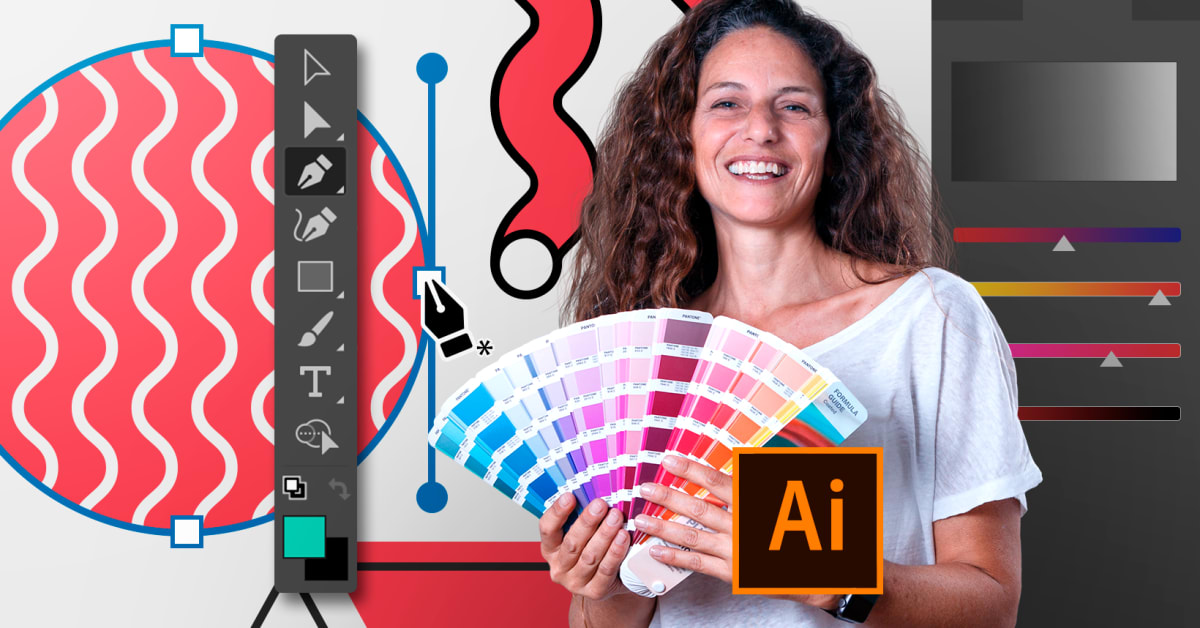Description
What you’ll learn:
- Working with documents and artboards
- Navigating artwork by zooming and panning
- Drawing lines and shapes
- Mixing color and saving swatches
- Applying strokes, dashes, and arrows
- Creating and formatting type
Syllabus:
1. Documents
- A first look at Illustrator
- Opening from the Windows desktop
- Opening from the Macintosh Finder
- Introducing the Home screen
- Creating a new document
- The units of design: Points and picas
- The advanced document settings
- Activate missing fonts
- Modifying your new document
- Saving Illustrator artwork
- Closing open documents on the PC
- Closing open documents on the Mac
2. Artboards
- Pages of any size, at any angle
- Using the artboard tool
- Undo, Redo, and Revert
- Selecting multiple artboards
- Creating and duplicating artboards
- Five ways to resize artboards
- Introducing the Artboards panel
- Navigating between artboards
- Aligning and distributing artboards
- Automatically tidying up your artboards
- Artboards and rulers
3. Navigate
- Getting around your artwork
- Zooming in and out
- Using the more precise Zoom tool
- Zooming on a selection
- GPU Performance and Animated Zoom
- Scrolling or panning a document
- Specifying a custom zoom level
- Working with multiple open documents
- Customizing your panels—important
- Saving your custom panels as a workspace
- Cycling between screen modes
- Trim View and Presentation Mode
4. Lines
- It’s time to draw
- Guidelines and center guides
- Positioning guides numerically
- Using the Line Segment tool
- Working with and without the bounding box
- Moving and duplicating objects
- Select Similar and Global Edit
- Introducing the Scissors tool
- Joining your line segments
- Introducing the Eyedropper tool
- Using the Arc tool
- Using the Spiral tool
- Using the Polar Grid tool
- Duplicating and scaling spirals
- Using the Rectangular Grid tool
- Auto-blending fill colors
- A preview of shape building
5. Shapes
- And now, we draw better
- Creating a time-saving template
- Using the Ellipse tool
- Live ellipses and pies
- Drawing two perfectly aligned circles
- Creating compound paths
- Using the Rectangle tool
- The dynamic round corner controls
- Adding some simple reflections
- Rotating your artwork into position
- Using the Polygon and Star tools
- Working with live polygons
- Creating the perfect five-pointed star
- Repeating stars in alternating rows
- Introducing the group Isolation mode
- Adding a drop shadow to a layer
- Using the crazy Flare tool
- The top-secret tilde key trick
6. Color
- How color works
- The color modes: RGB versus CMYK
- Hue, saturation, and brightness
- Selecting a color from the spectrum
- Creating and applying swatches
- Working with global swatches
- Searching swatches by name
- Auto-deleting and adding swatches
- Using the Eyedropper tool
- Loading swatches from another document
7. Strokes
- The rich world of strokes
- Adjusting the line weight
- How strokes align to path outlines
- Caps, joins, and miter limit
- Making practical use of caps and joins
- Dashes and arrowheads
- Variable-width strokes
- Numerically adjusting width points
- Custom aligning strokes to paths
- Creating a custom width profile
- Creating a classic round-dotted outline
- Drawing a quick-and-dirty gear
- Combining multiple strokes
- Offsetting strokes to simulate depth
8. Type
- Text at its best
- Placing and flowing text
- Converting between area and point type
- Modifying the text frame
- Creating custom margins guides
- Changing the font and type style
- Introducing variable fonts
- Paragraph alignment
- Type size and leading
- Dialing in custom variable styles
- Creating your own custom italics
- Kerning characters of type
- Roman Hanging Punctuation
- Filling and stroking text
9. Building
- Join and the Shape Builder tool
- Using the Join command
- Using the Join tool
- Object > Path > Outline Stroke
- Using the Shape Builder tool
- More ways to use the Shape Builder
- Creating a real-world project
- Creating an inset reflection
- Coloring a path with the Shape Builder
- Sculpting with variable-width strokes
- Converting text to path outlines
- Gap detection and path splitting
- Drawing with the Shaper tool
- Combining paths with the Shaper tool
- Editing paths inside a Shaper group
10. Pencil
- Freeform drawing at its best
- Drawing freeform path outlines
- The Smooth tool and Path Eraser tool
- Extending and connecting paths
- Drawing straight and perpendicular lines
- Creating a tracing template
- Combining the Pencil with a drawing tablet
- Coloring your Pencil tool art
11. Paint
- The best tools for painting
- Painting with the Blob Brush tool
- Fusing path outlines together
- Blob Brush size and strategies
- Introducing the Eraser tool
- Reassigning keyboard shortcuts
- Painting background paths
- Erasing all kinds of paths
- Erasing and smoothing lumps
- The Blob Brush and the opacity value
- Painting with a drawing tablet
- Using the Simplify command
12. Curvature
- Drawing a path one point at a time
- Drawing with the Curvature tool
- Working with smooth and corner points
- Creating and editing open path outlines
- Tracing a photographic detail
- Adding a basic textured fill
- Shape-building a castle wall
- A first look at gradients
- Editing a shape with the Curvature tool
- A first look at object blends
- Duplicating and scaling a complex object
- Drawing a custom letterform
- Creating a rippling line segment
- Adding a piece of vector-based clipart
13. Pen
- The tool that can drawing anything
- Creating corner points
- Adding and deleting anchor points
- How smooth points work
- Drawing smooth points
- Drawing cusp points
- Using the Anchor point tools
- Real-world drawing with the Pen tool
- Drawing a very complex path outline
- Copying and repurpose path segments
- Drawing a lot with very few points
- Creating dimension with shadows
- Shading the eye, ear, and nose
- Drawing smoothly waving path outlines
14. Corners
- Making corners smooth
- The round corner widget
- Rounding off corner points
- Changing the corner type
- Rounding characters of type
- Absolute versus relative rounding
- Drawing with rounded rectangles
- Drawing an iPhone
- Decorating an iPhone screen
- Drawing a leather smartphone case
- Colorizing a line art template
- Turning corners into organic curves
- Reshaping rounded paths
15. Screen
- Saving for devices and the web
- Aligning objects to the pixel grid
- Aligning objects as you draw or modify them
- Aligning text to the pixel grid
- Introducing the Save for Web command
- Scaling your art to suit its destination
- For devices and presentations, use PNG
- Saving an 8-bit graphic
- Saving a JPEG image
- Saving vector-based SVG files
- Assigning a copyright
- Using the Export for Screens command
- Using the Asset Export panel
- Asset export time-saving tricks









